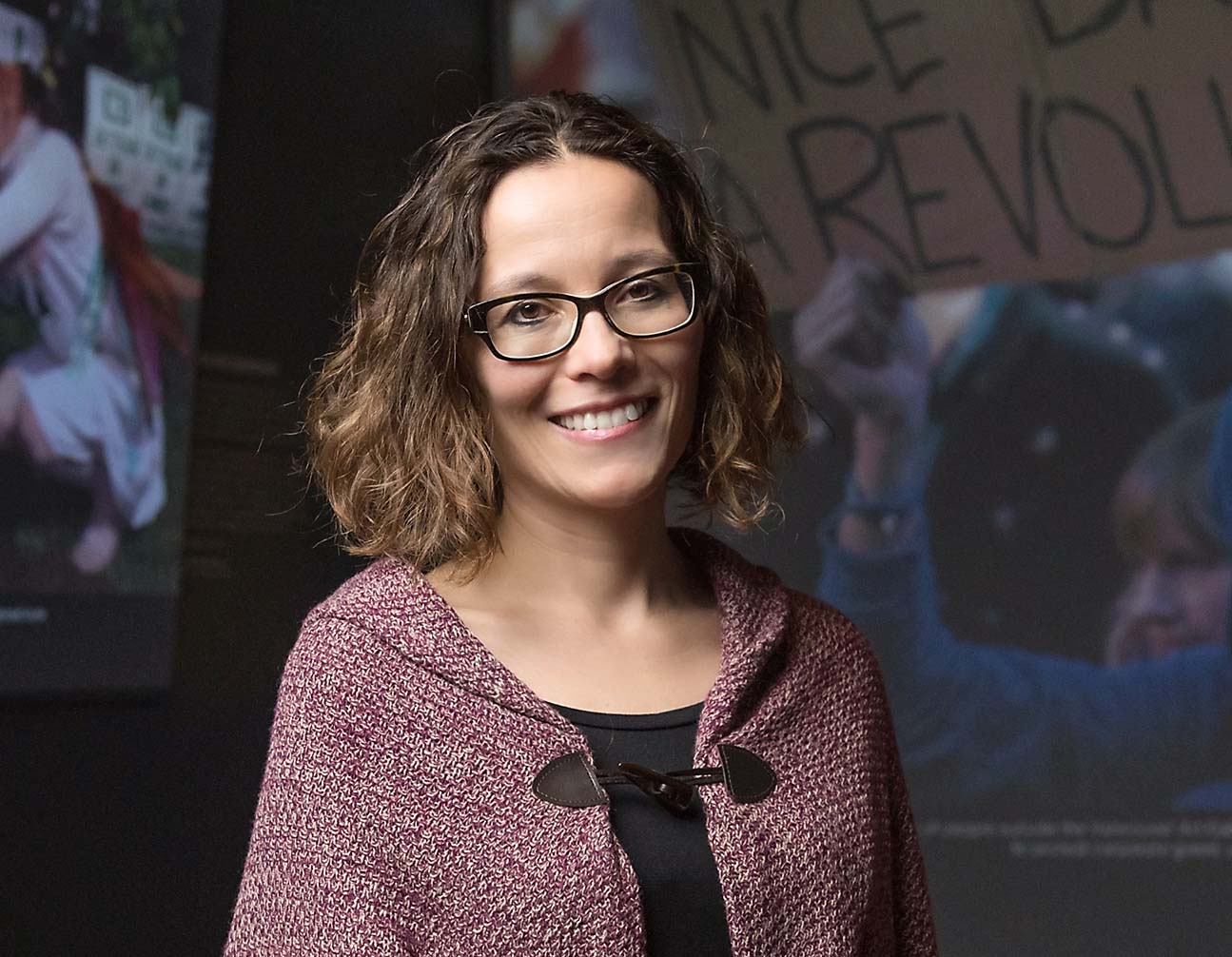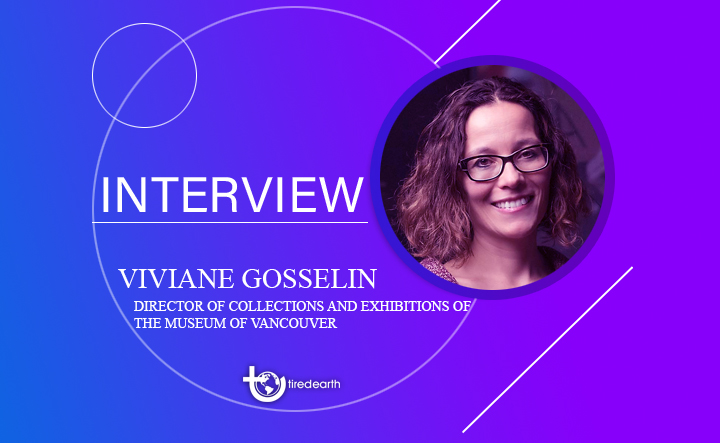03 Dec 2024

Viviane Gosselin
CA
Viviane Gosselin is a member of the Advisory Group for the Coalition of Museums for Climate Justice. She is the Director of Collections and Exhibitions for the Museum of Vancouver.

This interview was conducted by Selva Ozelli
The Museum of Vancouver (MOV) is the largest civic museum in Canada. When and how did the Museum of Vancouver get involved in climate change and sustainability-related issues?
MOV has been working for several years on public programs and exhibitions that look at sustainability Let me take you through a few initiatives to explain the evolution of our institutional approach to climate thinking and acting.
One of our earliest projects connected to climate education was Home Grown, a 2010 photo-based exhibition that explored local food production and sustainable farming in Vancouver and the surrounding region. The goal was to help urbanites regain control of local food systems and to encourage careful thinking about the ethics of food consumption embedded in everyday decisions. Workshops, screening, talks and tours provided a deeper understanding and appreciation of local food production issues as well as the inspiration and skills to start a backyard or community garden.
In 2014, we created the exhibition Rewilding Vancouver. This exhibition’s aim was to draw attention to the recent dramatic loss of biodiversity in the city. The project was a playful examination of the dynamic relationship between city dwellers and their natural environment that focused on the role of memory in mediating this relationship. The emergent discipline of historical ecology, or the history of nature, provided a theoretical framework for demonstrating the extent to which nature has been diminished and transformed by human activity – and our own obliviousness to these changes. With the tagline “Remember, Reconnect, Rewild,” Rewilding Vancouver became the first major exhibition in Canada to explore the anthropogenic degradation — which is to say degradation caused by humans — of a city’s natural environment through the lens of historical ecology. The exhibition narrative underscored the role of collective remembering and forgetting in shaping our understanding of what constitutes nature.
Several small wins came out of this project, some carefully crafted, others unplanned. The geographical specificity of the stories referenced in Rewilding Vancouver presented an opportunity to verify the application of several historical ecology concepts within a delineated geographic area, thus advancing discourses in historical ecology and environmental education. The project also inspired a Vancouver Parks Board task force aimed at making Vancouver the greenest city in the world. The City’s environmental education and stewardship action plan, also titled Rewilding Vancouver, drew on the exhibition by using the lens of historical ecology to frame its environmental messages.
In 2018, Wild Things: The Power of Nature in Our Lives examined the relationship between urbanites and their natural surroundings, with particular attention to personal stories of encounters with nature. These first-person narratives came from nature lovers, children, urban planners and Indigenous knowledge holders. The exhibition capitalized on the power of storytelling to evoke the range of emotions associated with meeting nature face-to-face and created an intimate and poetic space for thinking about personal connections (and disconnections) with nature in the city.
Wild Things was the first MOV exhibition to embody sustainability in its physical forms and materials. This meant a significant portion of the exhibition was built from reclaimed construction materials. Creating an exhibition within the parameters of reuse was the first step toward formalizing a policy of extensive upcycling in the fabrication of all MOV exhibitions. For MOV’s curatorial department and fabrication team, contributing to the shift to a circular economy has involved not only developing more and new ways of sourcing exhibition materials but also changes in the design, construction and use of display units. These efforts to reduce our consumption of raw materials triggered a fascinating chain reaction that has permanently altered MOV’s exhibition practice. For instance, our fabrication team started to work closely with the deconstruction community — businesses and organizations committed to sorting, cleaning up, redistributing and reselling construction materials. The result: Displays in the first 250 sq. meter gallery (Encounter Room) met our target of 70% reclaimed material. Approximately 30% of the displays in the second 250 sq. meter gallery (Engagement Room) were made of salvaged material. We also created a deconstruction plan for all the materials used in the exhibition, determining the reuse of each exhibition unit ahead of time (e.g., offer them to other departments or institutions, disassemble them for reuse in future projects).
Since Wild Things, MOV has integrated climate perspectives in all its curatorial programs, regardless of the topic.
This year The International Committee for Museums and Collections of Science and Technology (CIMUSET) which is a scientific committee of the International Council of Museums (ICOM) during its 48th #CIMUSET Annual Conference: “Museums & Environmental Concerns, New Insights” -7-11 November 2021, will discuss how Science and Technology museums can address the climate emergency issue via education and exhibitions. What programs/initiatives has your Museum instituted addressing climate change and sustainability?
Initially we approached the matter project by project, focusing on education and curation. However, we soon felt the need to develop a more holistic and comprehensive approach to climate education and to transition to low-carbon alternatives in all aspects of museum operations.
We are now tracking the building’s energy consumption, our water use and our waste production. We are also reviewing procurement guidelines. We now select our printers, caterers, conservation product suppliers and designers based on their ability to reduce our carbon footprint. We want to hear about concrete actions they have taken to reduce waste and ban the use of plastic in their operations. This sustainability audit with our suppliers and contractors is a way to amplify our climate action.
By taking a slow curation approach to exhibition development, MOV has reduced the number of large exhibitions produced annually and puts more emphasis on participatory models of research and creation and on long-term relationships with co-creators and knowledge holders. These collaborative exhibitions also make for better public programming. MOV’s suite of public programs (online and in-person) offer rich opportunities to generate discussion and inspire climate awareness and action among the large cast of exhibition contributors and diverse museum audiences they attract. And, bonus, public programs are less resource-intensive than exhibitions! ”Build your own bat house” workshops, biking tours focused on ethical urban foraging and interpretive nature walks in our parks all help us reconnect with the natural world, which is key to caring for the planet. As part of our “COVID19 pivoting,” and That Which Sustains Us exhibition project, MOV programmers developed a series of highly successful online maker workshops on weaving, fish skin leather tanning and fabric dyeing with mushrooms to name a few. These programs helped us reach new and more remote audiences. Although these workshops do not specifically educate participants about climate change, they propose a more sustainable way of interacting with the natural world.
What partnerships has MOV developed to help mitigate and adapt to Climate Change?
Over the years, MOV has developed a network of local and regional organizations and communities invested in environmental and climate education. For instance, with the Vancouver Economic Commission, we developed design strategies to support a circular economy. We worked with Nature Vancouver and environmental activist and writer James MacKinnon to develop our environmental literacy. MOV has built long-term and mutually beneficial relationships with Vancouver’s Indigenous host
host communities — xʷməθkʷəy̓əm (Musqueam), Sḵwx̱wú7mesh (Squamish), and səlilwətaɬ (Tsleil-Waututh) Nations — who have generously shared with MOV staff and visitors their traditional knowledge and wisdom, which includes a deep respect for and understanding of the land.
MOV has become a platform to showcase eco-artwork such as Uninterrupted, a virtual reality cinematic experience that examines the impact cities have on salmon habitats, or the 81-lb Challenge fashion exhibition, designed to inspire people to reduce consumption by upcycling clothing. MOV has begun a multi-year partnership with the University of British Columbia’s Department of History and its Faculty of Land and Food Systems to create public programs at the intersection of migration and community food security.
The Museum of Vancouver is affiliated with the Coalition of Museums for Climate Justice. As an institutional member of the advisory group of CMCJ, tell us more about CMCJ’s vision and actions?
Government inertia and the absence of effective climate policies with and for the arts and culture sector in Canada has forced museums to navigate their “climate learning” journey largely alone.
In 2016 museum professionals formed the Coalition of Museums for Climate Justice (CMCJ) as a way to fill this gap. CMCJ is an unincorporated, volunteer-run association that mobilizes Canadian museum professionals and their organizations to build public and institutional awareness and resilience in the face of climate change.
To support museums as they collectively rethink their operations by applying a sustainability lens, CMCJ used its limited resources to develop a website and social media platforms where partners and related organizations can share resources. The focus is ideas, practical tools and concrete actions that address the climate crisis and will help museums become more effective and impactful climate educators and advocates.
CMCJ partners with universities invested in training the next generation of museum professionals and with museum associations committed to increasing climate literacy among museum professionals and expanding their climate tool kit. CMCJ has joined several cross-sectoral alliances to support the transition to carbon neutrality in the arts and culture sector at large. One such partnership adapted Julies’ Bicycle Creative Green Tools (carbon footprinting tools made specifically for arts and culture) for use in Canada. CMCJ is also developing partnerships with groups that seek to harness the transformative power of artists and creatives across disciplines to help people imagine new terms of engagement with the natural world and new conceptions of individual and social well-being.
Several studies have demonstrated that museums are one of the most trusted sources of information in the Western world. Underpinning the work of CMCJ is the belief that museums must honour that trust by leveraging their power to help reverse destructive patterns and heal communities, ecosystems and the planet.
Anything else you want to add?
I just want to stress that it’s clear to CMCJ that social and environmental justice are interconnected. The cultural and structural forces that gave us colonialism, white supremacy, racism and social disparity are the same structures that have made us forget our connection and responsibility to the land and caused today’s climate crisis. As a cultural institution designed to perpetuate Western social values, museums have wittingly or unwittingly helped normalize racist and colonial attitudes, inequality, environmental disconnect and excessive consumption. The ethical “next move” for museums is to address the climate crisis head on and promote alternative social values such as well-being, inclusive and regenerative growth.
Comment